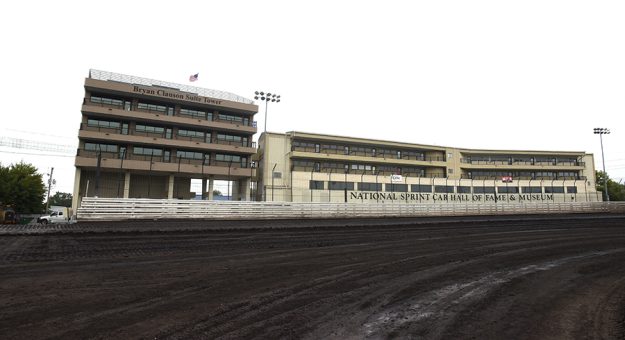He picked up track championships at Knoxville in 1981 and ‘82 and racked up a ton of victories. Eventually, he returned to California and claimed Northern Auto Racing Club titles in 199 and ‘92.
Green hoped his day would come, but as years went by, he wondered if his career had been forgotten. Then Bob Baker called.
“I didn‘t believe it at first,” Green said. “I was kind of in shock and I sat there for about 30 seconds. Bob finally asked if I was still there. I thought I had a pretty decent career and I tried to treat people well and help others.
 After the championships and awards you win, this is the next thing that caps it off.”
After the championships and awards you win, this is the next thing that caps it off.”
Then came a moment that may be the most special of all.
“After I got off the phone my wife asked what was wrong. I told her that the call was from Bob Baker from the National Sprint Car Hall of Fame,” Green explained. “She looked at me and said, ‘Did you get in?‘ I said, ‘Yes,‘ and she started crying. She was so much a part of my career and recoveries. She was there for all of it. Changing the dressings on my burns and taking care of me after I got sick from an infection in my knee. She has been through more than me.”
Many of the inductees share similar stories. This award isn‘t just about them, it is also about those who supported them during the journey.
Schmeh had his moment in the sun, too, although he acknowledges it made him a bit uncomfortable. He felt it was hard to be honored for a job that he received a paycheck for. Others disagreed. He already had a personal payoff.
Every time he looks at the Hall of Fame there is a deep sense of pride. He knows the work he and others put in to make this a reality. The work continues.
“I‘m excited about the future of what was once my baby,” Schmeh said.
32nd National Sprint Car Hall of Fame Induction Class
Bob Frey was a five-time winner of the Little 500 and pavement ace who won across the country with a range of sanctioning bodies. Perhaps his most impressive victory came in the 1989 Little 500 when he made up a seven-lap deficit aboard Glen Niebel‘s famed V-6-powered sprinter.
John Gibson is known as “The Voice of the World of Outlaws,” and has worked more than 2,000 consecutive World of Outlaws races. No one has announced more sprint car races than Gibson. He has been instrumental in transforming a World of Outlaws race into a true event.
Eric Gordon has piloted sprint cars for more than 30 years and was the 1989 USAC Rookie of the Year. He was the USAC sprint car runner-up three times and won the Little 500 at Anderson (Ind.) Speedway a staggering nine times.
Terry Gray is a second-generation racer who first won with the World of Outlaws in 1980. He has scored four ASCS National championships. In 2001 he turned his attention to the USCS and has been a dominant force for over two decades punctuated by 13 championships to date.
Tim Green hailed from California but after a fourth-place finish in World of Outlaws points, he moved to the Midwest and won back-to-back track championships at Knoxville Raceway. He returned to his native state where he earned two NARC titles. Green was the 1979 Western World champion at Manzanita and won three Skagit Dirt Cups.
Ralph Heintzelman Sr. was one of the top manufacturers and mechanics in Pennsylvania in the 1970s. He turned wrenches for Jan Opperman and the result was a 44-win season in 1972 and a Selinsgrove (Pa.) Speedway track title in 1973. Heintzelman also worked with Hall of Famer Lynn Paxton. The results included a track championship at Port Royal and a win in the prestigious Tuscarora 50.
Jack Kromer‘s career began in the 1970s and he logged 26 cover shots for Open Wheel Magazine, the most by any photographer. He holds more than 30 first-place awards from the Eastern Motorsports Press Association and the American Auto Racing Writers and Broadcasters for racing imagery.
Robin Miller was one of the most recognized writers and personalities in the sport. He wrote for the Indianapolis Star from 1968 to 2001. He also toiled for Autoweek, Car and Driver, ESPN and Speed.
Walter T. Ross owned the iconic No. 56 sprint car that was a consistent presence in California for years. During the 1970s he had notable success with drivers like Mike Andreetta, Hank Butcher, Lem Tolliver and Aussie, Garry Rush. His most success would come in his time with Gary “Preacher” Patterson.
Dennis Roth is well known for his “Beef Packers” sprint car. His first championship came in 1994 with the Rebel 360 Series. Moving to the World of Outlaw trail, by 1998, he was a Knoxville Nationals champion with Danny Lasoski. His cars have won three Skagit Dirt Cups and multiple King of the West championships.
Walter “Slim” Rutherford hailed from Whiting, Ind., and was one of the leading builders, fabricators, and innovators in the 1930s and ‘40s. Rutherford won races across the Midwest in what were then known as Big Cars.
Tony Stewart was the first driver to win the USAC Triple Crown in a single season and has also recorded wins with the World of Outlaws, All Stars and several other series. As an owner, he has accumulated nine WoO titles as well as 11 Knoxville Nationals and five King‘s Royal victories.
![]()
